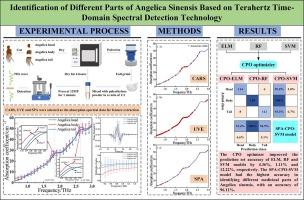太赫兹时域光谱和基于化学计量学的凤头豪猪算法在鉴定当归不同药用部位中的应用
IF 3.1
3区 物理与天体物理
Q2 INSTRUMENTS & INSTRUMENTATION
引用次数: 0
摘要
目的当归是中医临床常用的中药材之一,由于其头、身、尾有效成分含量的差异,表现出不同的药理特征。因此,研究当归不同药用部位的鉴别方法具有重要的现实意义。太赫兹时域光谱(THz-TDS)技术因其独特的电磁波特性被广泛应用于无损检测领域。本研究探讨了太赫兹时域光谱技术与化学计量学相结合识别当归不同药用部位的可行性。方法通过比较当归不同部位的光谱响应特征与各种光学参数的关系,选取 0.6-3.0太赫兹范围内的吸收系数光谱,采用联合竞争自适应重加权采样(CARS)、无信息变量消除(UVE)和连续投影算法(SPA)三种特征提取算法,依次建立极限学习机(ELM)、随机森林(RF)和支持向量机(SVM)分类模型,并利用冠豪猪算法(Crested Porcupine Optimizer,CPO)对模型进行优化。结果研究结果表明,CPO 优化器显著提高了模型的分类准确率,ELM、RF 和 SVM 模型的准确率分别提高了 4.36%、1.11% 和 12.22%。结果表明,完全联合的特征提取策略和优化算法能在模型构建中发挥强大的协同效应,证实了太赫兹-TDS 技术正确识别当归不同药用部位的可行性,为太赫兹技术在中药材鉴定中的应用提供了重要参考。本文章由计算机程序翻译,如有差异,请以英文原文为准。

Application of terahertz time-domain spectroscopy and chemometrics-based crested porcupine algorithm in identification of different medicinal parts of Angelica sinensis
Objective
Angelica sinensis is one of the commonly used Chinese herbal medicine in traditional Chinese medicine clinic, exhibits different pharmacological characteristics due to variations in the content of active ingredients in its head, body, and tail. Therefore, research on the identification methods of different medicinal parts of Angelica sinensis is of great practical significance. Terahertz Time-Domain Spectroscopy (THz-TDS) technology is widely used in the field of nondestructive testing because of its unique electromagnetic wave characteristics. This study explores the feasibility of combining THz-TDS with chemometrics to identify different medicinal parts of Angelica sinensis.
Methods
By comparing the spectral response characteristics of different parts of Angelica sinensis to various optical parameters, the absorption coefficient spectrum in the 0.6–3.0 THz range was selected, and three types of feature extraction algorithms, namely, joint Competitive Adaptive Reweighted Sampling (CARS), Uninformative Variable Elimination (UVE), and Successive Projections Algorithm (SPA), were used to establish the classification models of Extreme Learning Machine (ELM), Random Forest (RF), and Support Vector Machine (SVM) in turn, and optimize the models by using the crown porcupine algorithm (Crested Porcupine Optimizer (CPO) to optimize the model.
Results
The research results indicate that the CPO optimizer significantly improved the classification accuracy of the models, with the accuracy of the ELM, RF, and SVM models increasing by 4.36%, 1.11%, and 12.22%, respectively. The SPA-CPO-SVM model exhibited the best overall performance, achieving accuracies of 96.11% and 97.96% on the prediction and training sets, respectively, while the number of input features was only 5% of the total feature set.
Conclusion
The results show that the fully joint feature extraction strategy and optimization algorithm can play a powerful synergistic effect in model construction, confirming the feasibility of THz-TDS technology to correctly identify different medicinal parts of Angelica sinensis, and providing an important reference for the application of terahertz technology in the identification of Chinese herbal medicines.
求助全文
通过发布文献求助,成功后即可免费获取论文全文。
去求助
来源期刊
CiteScore
5.70
自引率
12.10%
发文量
400
审稿时长
67 days
期刊介绍:
The Journal covers the entire field of infrared physics and technology: theory, experiment, application, devices and instrumentation. Infrared'' is defined as covering the near, mid and far infrared (terahertz) regions from 0.75um (750nm) to 1mm (300GHz.) Submissions in the 300GHz to 100GHz region may be accepted at the editors discretion if their content is relevant to shorter wavelengths. Submissions must be primarily concerned with and directly relevant to this spectral region.
Its core topics can be summarized as the generation, propagation and detection, of infrared radiation; the associated optics, materials and devices; and its use in all fields of science, industry, engineering and medicine.
Infrared techniques occur in many different fields, notably spectroscopy and interferometry; material characterization and processing; atmospheric physics, astronomy and space research. Scientific aspects include lasers, quantum optics, quantum electronics, image processing and semiconductor physics. Some important applications are medical diagnostics and treatment, industrial inspection and environmental monitoring.

 求助内容:
求助内容: 应助结果提醒方式:
应助结果提醒方式:


